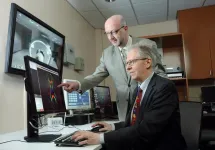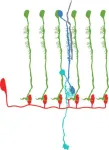(Press-News.org) Traditional solutions for sleep disorders, including medications and cognitive behavioral therapies, often provide insufficient relief for military personnel, a problem researchers from the University of Arizona College of Medicine – Tucson will be hoping to solve with a $3 million grant from the Department of Defense Congressionally Directed Medical Research Program.
Sleep problems are among the top health concerns of military personnel, with an estimated 85% meeting criteria for a clinically relevant sleep disorder and as many as 25% identifying insomnia as a primary issue. The impact of sleeplessness on force readiness is profound, creating a critical need for developing innovative, effective, nondrug interventions.
Image
For the past decade, William “Scott” Killgore, PhD, an Army veteran, has focused much of his work around factors affecting the mental health, well-being and performance of military personnel.
Photo by Noelle Haro-Gomez, U of A Health Sciences Office of Communications
William “Scott” Killgore, PhD, and his team in the Social, Cognitive and Affective Neuroscience, or SCAN, Lab in the Department of Psychiatry hope to fill that need.
“Insomnia is generally believed to be caused, at least in part, by excessive arousal of the brain and body, which is often associated with worry and excessive pre-sleep negative and arousing thoughts,” said Killgore, a professor of psychiatry and member of the BIO5 Institute.
Brain imaging has shown that internally focused thoughts tend to activate the default mode network, or DMN, a core system in the brain that processes internal thoughts and emotions and becomes active during rest or introspective activities. Killgore and his team recently completed a preliminary study to suppress the DMN before sleep using a handheld device that stimulates brain cells with magnetic fields.
Their device, which is held against the scalp for less than a minute, uses transcranial magnetic stimulation to target specific areas of the brain with continuous theta burst stimulation, which delivers rapid, repetitive bursts of magnetic pulses to inhibit brain activity. Transcranial magnetic stimulation is well-tolerated.
“Many people with insomnia describe being unable to ‘turn off’ their thoughts when trying to fall asleep,” Killgore said. “This internal dialog, worry and rumination is facilitated by activation within the DMN, perpetuating a cycle of restlessness. Our study’s initial findings suggest that by disrupting this brain network through a brief, 40-second stimulation, we can effectively help individuals achieve better sleep.”
Participants showed improvements in sleep after one session of continuous theta burst stimulation to a single region of the DMN.
The general use of continuous theta burst stimulation for sleep, depression and other mental health issues is not new, but Killgore’s specific approach stimulates a network in the brain that has not been explored for this purpose.
Bolstered by these preliminary findings and the new grant, the research team is launching an expanded, three-year study to examine the long-term effects of 10 repeated administrations of continuous theta burst stimulation over a two-week period.
They will recruit 120 participants with chronic insomnia and assess sleep improvements over several months. Participants will receive brief brain-stimulation sessions, and their sleep will be monitored using state-of-the-art sleep trackers and portable at-home brain wave monitors.
“By investigating how different areas of the brain respond to continuous theta burst stimulation, we hope to fine-tune this approach for maximum effectiveness,” Killgore said. “Our aim is to see whether we can improve sleep in the short term and if these improvements can be sustained following treatment.”
The research team includes two active-duty military consultants with sleep disorders. Their insights and feedback have shaped the study’s design, and they will provide guidance on how to translate the results into meaningful changes for the military community.
This study is part of a broader effort to address two crucial focus areas outlined by Congress’ Traumatic Brain Injury and Psychological Health Research Program: reducing the risk of psychological health conditions and developing novel treatments and interventions.
“This innovative project has tremendous potential to open new avenues for treating one of the major health concerns facing service members, as well as those in the civilian community,” said Jordan Karp, MD, psychiatry professor and department chair. “This would represent an important discovery for sleep science and would offer a tangible, drug-free treatment option for those grappling with chronic insomnia and other sleep disorders.”
Traditional solutions for sleep disorders, including medications and cognitive behavioral therapies, often provide insufficient relief for military personnel, a problem researchers from the University of Arizona College of Medicine – Tucson will be hoping to solve with a $3 million grant from the Department of Defense Congressionally Directed Medical Research Program.
Sleep problems are among the top health concerns of military personnel, with an estimated 85% meeting criteria for a clinically relevant sleep disorder and as many as 25% identifying insomnia as a primary issue. The impact of sleeplessness on force readiness is profound, creating a critical need for developing innovative, effective, nondrug interventions.
Image
For the past decade, William “Scott” Killgore, PhD, an Army veteran, has focused much of his work around factors affecting the mental health, well-being and performance of military personnel.
Photo by Noelle Haro-Gomez, U of A Health Sciences Office of Communications
William “Scott” Killgore, PhD, and his team in the Social, Cognitive and Affective Neuroscience, or SCAN, Lab in the Department of Psychiatry hope to fill that need.
“Insomnia is generally believed to be caused, at least in part, by excessive arousal of the brain and body, which is often associated with worry and excessive pre-sleep negative and arousing thoughts,” said Killgore, a professor of psychiatry and member of the BIO5 Institute.
Brain imaging has shown that internally focused thoughts tend to activate the default mode network, or DMN, a core system in the brain that processes internal thoughts and emotions and becomes active during rest or introspective activities. Killgore and his team recently completed a preliminary study to suppress the DMN before sleep using a handheld device that stimulates brain cells with magnetic fields.
Their device, which is held against the scalp for less than a minute, uses transcranial magnetic stimulation to target specific areas of the brain with continuous theta burst stimulation, which delivers rapid, repetitive bursts of magnetic pulses to inhibit brain activity. Transcranial magnetic stimulation is well-tolerated.
“Many people with insomnia describe being unable to ‘turn off’ their thoughts when trying to fall asleep,” Killgore said. “This internal dialog, worry and rumination is facilitated by activation within the DMN, perpetuating a cycle of restlessness. Our study’s initial findings suggest that by disrupting this brain network through a brief, 40-second stimulation, we can effectively help individuals achieve better sleep.”
Participants showed improvements in sleep after one session of continuous theta burst stimulation to a single region of the DMN.
The general use of continuous theta burst stimulation for sleep, depression and other mental health issues is not new, but Killgore’s specific approach stimulates a network in the brain that has not been explored for this purpose.
Bolstered by these preliminary findings and the new grant, the research team is launching an expanded, three-year study to examine the long-term effects of 10 repeated administrations of continuous theta burst stimulation over a two-week period.
They will recruit 120 participants with chronic insomnia and assess sleep improvements over several months. Participants will receive brief brain-stimulation sessions, and their sleep will be monitored using state-of-the-art sleep trackers and portable at-home brain wave monitors.
“By investigating how different areas of the brain respond to continuous theta burst stimulation, we hope to fine-tune this approach for maximum effectiveness,” Killgore said. “Our aim is to see whether we can improve sleep in the short term and if these improvements can be sustained following treatment.”
The research team includes two active-duty military consultants with sleep disorders. Their insights and feedback have shaped the study’s design, and they will provide guidance on how to translate the results into meaningful changes for the military community.
This study is part of a broader effort to address two crucial focus areas outlined by Congress’ Traumatic Brain Injury and Psychological Health Research Program: reducing the risk of psychological health conditions and developing novel treatments and interventions.
“This innovative project has tremendous potential to open new avenues for treating one of the major health concerns facing service members, as well as those in the civilian community,” said Jordan Karp, MD, psychiatry professor and department chair. “This would represent an important discovery for sleep science and would offer a tangible, drug-free treatment option for those grappling with chronic insomnia and other sleep disorders.”
END
Can magnetic pulses aimed at the brain treat insomnia?
Researchers at the College of Medicine – Tucson’s Department of Psychiatry will use a $3M grant from the Department of Defense to examine a noninvasive, drug-free treatment for sleep disorders.
2024-10-31
ELSE PRESS RELEASES FROM THIS DATE:
F.M. Kirby Research Center honors 25 years of pioneering brain imaging research
2024-10-31
BALTIMORE, October 31, 2024— Kennedy Krieger Institute is proud to celebrate the 25th anniversary of the F.M. Kirby Research Center for Functional Brain Imaging at Kennedy Krieger Institute, a leader in advancements and research in understanding the human brain.
Established in 1999 in partnership with Johns Hopkins University School of Medicine, the center has transformed neuroscience and medical imaging by developing cutting-edge magnetic resonance imaging (MRI) techniques that allow researchers to examine and measure brain function and structure ...
$1.75M CDC grant funds study to boost vaccine acceptance in Arizona’s rural, border communities
2024-10-31
Researchers at the University of Arizona’s Mel and Enid Zuckerman College of Public Health received a $1.75 million Centers for Disease Control and Prevention grant to conduct a community-based, participatory research study designed to improve vaccine uptake in Arizona’s rural and border communities.
Vaccination is a highly effective public health intervention that saves millions of lives per year, yet vaccination rates have declined in recent years for a variety of reasons, ranging from safety concerns to religious and philosophical objections.
“Vaccination is a cornerstone of public health,” said co-principal investigator Tomas ...
Immune system review provides insight into more effective biotechnology
2024-10-31
Macrophage cells are the immune system’s frontline soldiers, early on the scene to protect the body from foreign invaders. These cells answer the immune system's critical question for the rest of its troops: friend or foe?
As critical responders, macrophages can perceive helpful biotechnology as threats. If not created with the right materials or mechanical forces, these devices can trigger an immune response that can cause inflammation, scar tissue or device failure.
But what is the right material or the right mechanical force? In a meta-analysis co-led ...
Remote control eddies: Upwelled nutrients boost productivity around Hawaiian Islands
2024-10-31
Beyond colorful coral reefs and diverse nearshore ecosystems, Pacific Ocean waters surrounding the Hawaiian Islands have comparatively little marine life and low biological productivity. New research published by University of Hawai‘i (UH) at Mānoa oceanographers showed that eddies on the leeward side of the Hawaiian Islands can supply nutrients, not only locally, but also to the opposite side of the island chain and stimulate blooms of phytoplankton, microscopic plant life that lives in the surface ocean.
The study, published in JGR Oceans, was selected by the American Geophysical Union’s editorial board as a featured article.
“While ...
Rice, Texas Medical Center institutions jointly award seed grants
2024-10-31
Rice University together with Baylor College of Medicine and the Houston Methodist Academic Institute has awarded seed grants in support of research on health equity and digital health.
Spearheaded by Rice’s Educational and Research Initiatives for Collaborative Health (ENRICH) office in collaboration with the two partnering institutions in the Texas Medical Center (TMC), the seed grant opportunity followed the Health Equity Workshop hosted earlier this year by Rice’s Digital Health Initiative.
“To achieve equitable health outcomes, a comprehensive approach is essential — one ...
Sleeping for 2: Insomnia therapy reduces postpartum depression, study shows
2024-10-31
While many people believe that poor sleep during pregnancy is inevitable, new research has determined that cognitive behavioral therapy for insomnia (CBTi) while pregnant can not only improve sleep patterns but also address postpartum depression.
Researchers from UBC’s Okanagan and Vancouver campuses, as well as the University of Calgary, discovered that delivering CBTi during pregnancy significantly reduces postpartum depressive symptoms after a baby arrives.
“Early intervention is crucial for infant and parental mental health,” says Dr. Elizabeth Keys, an Assistant Professor in UBCO’s School of Nursing and a study co-author. “Our research explores how addressing ...
How fruit flies achieve accurate visual behavior despite changing light conditions
2024-10-31
When light conditions rapidly change, our eyes have to respond to this change in fractions of a second to maintain stable visual processing. This is necessary when, for example, we drive through a forest and thus move through alternating stretches of shadows and clear sunlight. "In situations like these, it is not enough for the photoreceptors to adapt, but an additional corrective mechanism is required," said Professor Marion Silies of Johannes Gutenberg University Mainz (JGU). "Earlier work undertaken by her research group had already demonstrated that such a corrective 'gain control' mechanism exists ...
First blueprint of the human spliceosome revealed
2024-10-31
Researchers at the Centre for Genomic Regulation (CRG) in Barcelona have created the first blueprint of the human spliceosome, the most complex and intricate molecular machine inside every cell. The scientific feat, which took more than a decade to complete, is published today in the journal Science.
The spliceosome edits genetic messages transcribed from DNA, allowing cells to create different versions of a protein from a single gene. The vast majority of human genes – more than nine in ten – are edited by the spliceosome. Errors in the process are linked to a wide spectrum of diseases including most types of cancer, neurodegenerative conditions and genetic ...
The harmful frequency and reach of unhealthy foods on social media
2024-10-31
An analysis of social media posts that mention food and beverage products finds that fast food restaurants and sugar sweetened beverages are the most common, with millions of posts reaching billions of users over the course of a year. The study, published in the open access journal PLOS Digital Health, highlights the sheer volume of content normalising unhealthy eating, and argues that policies are needed to protect young people in the digital food environment.
Obesity is a health challenge around the world and food environments, including in the digital space, can influence ...
Autistic traits shape how we explore
2024-10-31
People with stronger autistic trails showed distinct exploration patterns and higher levels of persistence in a computer game, ultimately resulting in better performance than people with lower scores of autistic traits, according to a new study published this week in PLOS Computational Biology by Francesco Poli of Radboud Universiteit, the Netherlands, and colleagues.
Scientists know that individuals display curiosity and explore their environments to learn. How a person selects what they want to explore plays a pivotal role in how they learn and research has shown that exploration levels are highly variable across ...
LAST 30 PRESS RELEASES:
Post-stroke injection protects the brain in preclinical study
Cardiovascular risk score predicts multiple eye diseases
Health: estimated one in ten British adults used or interested in GLP-1 medications for weight loss
Exercise to treat depression yields similar results to therapy
Whooping cough vaccination for pregnant women strengthens babies’ immune system
Dramatic decline in new cases of orphanhood in Uganda driven by HIV treatment and prevention programs
Stopping weight loss drugs linked to weight regain and reversal of heart health markers
Higher intake of food preservatives linked to increased cancer risk
Mass General Brigham–developed cholera vaccine completes phase 1 trial
First experimental validation of a “150-year-old chemical common sense” direct visualization of the molecular structural changes in the ultrafast anthracene [4+4] photocycloaddition reaction
Lack of support for people on weight loss drugs leaves them vulnerable to nutritional deficiencies, say experts
Dogs’ dinners can have greater climate impact than owners’
Are you ready to swap salmon for sprats and sardines?
1.6 million UK adults used weight loss drugs in past year
American College of Cardiology comments on new dietary guidelines for Americans
American Society of Gene & Cell Therapy and Orphan Therapeutics Accelerator partner to advance and commercialize promising rare disease treatments
One in 14 patients having day case surgery have new or worse chronic pain 3 months after their operation
New study highlights link between eviction rates and gun violence
Heatwaves heat up soil but not toxin levels in rice, study finds
Digital modeling reveals where construction carbon emissions really come from
Turning farm waste into water filters
New study shows how the spleen helps the immune system accept a transplant
New Mayo Clinic study advances personalized prostate cancer education with an EHR-integrated AI agent
Researchers identify novel therapeutic target to improve recovery after nerve injury
Microbes in breast milk help populate infant gut microbiomes
Reprogramming immunity to rewrite the story of Type 1 diabetes
New tool narrows the search for ideal material structures
Artificial saliva containing sugarcane protein helps protect the teeth of patients with head and neck cancer
Understanding the role of linear ubiquitination in T-tubule biogenesis
Researchers identify urban atmosphere as primary reservoir of microplastics
[Press-News.org] Can magnetic pulses aimed at the brain treat insomnia?Researchers at the College of Medicine – Tucson’s Department of Psychiatry will use a $3M grant from the Department of Defense to examine a noninvasive, drug-free treatment for sleep disorders.







